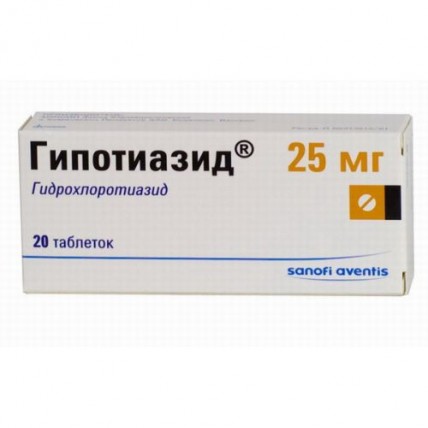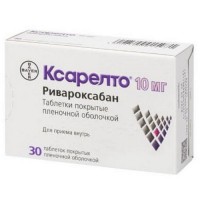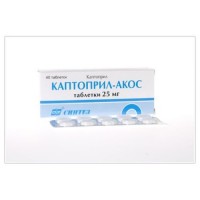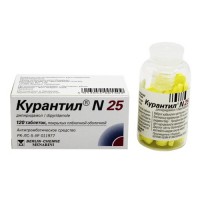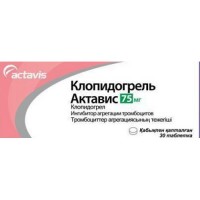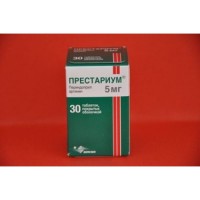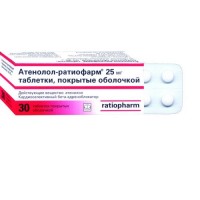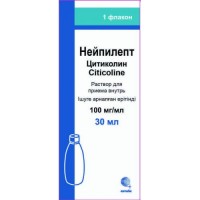25 mg hydrochlorothiazide (20 tablets)
- $9.30
Out Of Stock
The instruction for medical use
of GIPOTIAZID medicine
the Trade name
of Gipotiazid
the International unlicensed
name Hydrochlorothiazide Dosage Form
of the Tablet of 25 mg, 100 mg
Structure
One tablet contains
active agent - a hydrochlorothiazide of 25 mg or 100 mg,
excipients: magnesium stearate, gelatin, talc, starch corn, lactoses monohydrate.
Description
White or almost white flat tablets. On one party there is a marking of 'N', on another – the dividing line
Pharmacotherapeutic group
Diuretics, tiazida.
The code of automatic telephone exchange C03AA03
the Pharmacological
Pharmacokinetics Hydrochlorothiazide properties is well soaked up after intake, its diuretic and natriuretichesky actions are shown within 2 hours and reach the maximum approximately in 4 hours. This action remains within 6 – 12 hours. Linking with proteins of blood plasma makes 40%. Primary way of removal through kidneys in not changed form. Elimination half-life for patients with normal renal function makes 6.4 hours, for patients with a moderate renal failure – 11.5 hours, and in a heavy renal failure with clearance of creatinine less than 30 ml/min. – 20.7 hours. Hydrochlorthiazidum gets through a placental barrier and in small quantities is excreted in breast milk.
The pharmacodynamics
the Basic principle of action of the Hydrochlorothiazide consists in its oppressing influence on function of an epithelium of renal tubules. It is shown mainly in reduction of a reabsorption of ions of sodium, chlorine and the corresponding amounts of water. The hydrochlorothiazide oppresses a reabsorption of ions of sodium and chlorine generally in an initial part of distal tubules at the expense of inhibition of the transport system of ions of sodium and chlorine. Drug also has some impact on proximal tubules. In small degree inhibits a karboangidraza that is shown in decrease in a reabsorption of a hydrocarbonate. Increases secretion of potassium ions, breaks excretion of ions of magnesium. All this leads to increase in discharge with urine of ions of sodium, chlorine and also potassium, magnesium and bicarbonate, without significant change rn urine. The diuretic effect occurs in 2 hours, reaches a maximum in 4 hours and 6-12 hours proceed. At prolonged use the Hydrochlorothiazide delays excretion by kidneys of calcium ions that can render favorable effect in the presence of nephroliths, calcigerous. In small doses the Hydrochlorothiazide reduces removal of uric acid and can cause a hyperuricemia, in the presence of gout its course in this case is aggravated. In high doses promotes removal of uric acid. Keeps activity in acidosis and an alkalosis. Accustoming to the Hydrochlorothiazide practically does not arise. Elderly people are more sensitive to diuretic effect of drug. Besides diuretic action, drug possesses also hypotensive action, due to reduction of volume of extracellular liquid that is reached as a result of removal of ions of sodium, chlorine and water, and expansion of arterioles. Against the background of action of the Hydrochlorothiazide the efficiency of many antihypertensives increases. The hydrochlorothiazide does not affect normal arterial blood pressure. Antihypertensive action comes in 3-4 days, but for achievement of optimum therapeutic effect 3-4 weeks can be required. Hypotensive action remains within a week after drug withdrawal. In not diabetes drug paradoxically reduces a diuresis (the mechanism of action is not clear).
Indications
- arterial hypertension of I and II stage (in the form of monotherapy and in a combination with other antihypertensive drugs)
- not diabetes
- a hypercalcuria
the Edematous syndrome of various genesis
- in a heart, liver or renal failure (as a part of complex therapy)
- in the premenstrual period
- caused by drug intake (for example, at treatment by corticosteroids).
Route of administration and doses
the Dosage has to be picked up individually and demands constant medical control. Due to the strengthened loss of potassium and magnesium during treatment (potassium level in blood serum can fall lower than 3.0 mmol/l), there is a need for their timely compensation. The extra care should be observed at patients with heart failure, from the liver broken by function or at receiving treatment by foxglove glycosides. A pill should be taken after a meal.
Adults
as antihypertensive drug, the recommended initial daily dose makes 25-100 mg in one step, in the form of monotherapy or in a combination with other hypotensive drugs. Some patient of rather initial dose in 12.5 mg, both in the form of monotherapy, and in a combination. It is necessary to apply the minimal effective dose which is not exceeding 100 mg a day. If the Hydrochlorothiazide is combined with other hypotensive drugs, there can be a need for decrease in their doses for prevention of overshot hypotensive effect. Hypotensive action is shown within 3 – 4 days, however for achievement of optimum effect can be required up to 3 – 4 weeks.
After the end of treatment the hypotensive effect remains about one week. In not diabetes the recommended daily dose makes 50-150 mg (in 2 - 4 receptions).
The recommended dose at treatment of hypostases - 25-100 mg of drug once a day or every two days. Depending on clinical reaction the dose has to be reduced to 25 – 50 mg once a day or every two days. In some hard cases initial doses up to 200 mg a day can be required.
In hypostases in the premenstrual period the recommended dose makes 25 mg a day and is applied from the beginning of manifestation of symptoms prior to the beginning of periods.
The frequency rate of receptions and duration of a course depends on reaction of the patient to treatment and is defined by individually attending physician.
Children
of the Dose have to be established, proceeding from the body weight of the child. The recommended daily doses for children make 1 – 2 mg/kg of weight or 30 – 60 mg on square meter of a body surface, are appointed once a day. The general daily dose to children aged from 2 months up to 2 years makes 12.5-37.5 mg, aged from 2 up to 12 years – on 37.5-100 mg a day. Children of younger age of a tablet should give in the crushed view with liquid.
Elderly people the dose decline can be required.
Side effects
- a hypopotassemia, a hypomagnesiemia, a hypercalcemia and a gipokhloremichesky alkalosis: dryness in a mouth, thirst, arrhythmias of heart, change in mood or mentality, spasms and muscle pains, nausea, vomiting, unusual fatigue or weakness. The Gipokhloremichesky alkalosis can cause hepatic encephalopathy or a hepatic coma.
- hyponatremia: confusion of consciousness, convulsion, a lethargy, excitability, muscular spasms
- a hyperglycemia, a glucosuria, a hyperuricemia which can cause in asymptomatic gouty patients a gout attack
- a demonstration of latent diabetes
- increase in level of lipids of blood at use of high doses
- cholecystitis or pancreatitis, cholestatic jaundice, diarrhea, a sialadenitis, constipations, anorexia
- arrhythmias, orthostatic hypotension, a vasculitis
- dizziness, temporary illegibility of sight, a headache, paresthesia
- it is very rare: a leukopenia, an agranulocytosis, thrombocytopenia, hemolytic anemia, aplastic anemia
-urticaria, a purpura, a necrotic vasculitis, Stephens-Johnson's syndrome, a syndrome of a respiratory distress (including a pneumonitis and not cardiogenic hypostasis of a lung), photosensitivity, anaphylactic reactions up to shock
- disturbances of sexual function, a pneumonitis, a renal failure, interstitial nephrite.
Contraindications
- hypersensitivity to drug or to other sulfonamides
- heavy renal (the clearance of creatinine is lower than 30 ml/min.) or a liver failure
- an anury
- the lactation period.
Medicinal interactions
It is necessary to avoid simultaneous use of drug with:
- lithium salts (level of lithium can reach a toxicity threshold).
With care to apply with the following drugs:
- antihypertensive drugs (their action potentsiirutsya, need for dose adjustment can appear)
- cardiac glycosides (the hypopotassemia and a hypomagnesiemia interfaced to effect of thiazide diuretics increase risk of intoxication a foxglove)
- Amiodaronum (the hypopotassemia increases risk of arrhythmia)
- oral anti-diabetic drugs (their efficiency decreases, the hyperglycemia can develop)
- corticosteroid drugs, calcitonin (increase extent of removal of potassium)
- not depolarizing muscular relaxants (their effect can amplify)
- amantadiny since its toxicity
- holestiraminy which oppresses gastrointestinal absorption of Hydrochlorthiazidum
- non-steroidal anti-inflammatory drugs (NPVS weaken diuretic and hypotensive effect of Hydrochlorthiazidum)
- alcohol increases, barbiturates and drugs which enhance effect of orthostatic hypotension.
Interaction 'drug / laboratory analyses'
Tiazida reduce the level of the iodine connected with proteins in blood plasma. Before carrying out analyses on function of an epithelial body the hydrochlorothiazide should be cancelled. Concentration of bilirubin in blood plasma can be increased.
Special instructions
At a long course of treatment it is necessary to control carefully clinical symptoms of disturbance of water and electrolytic balance, first of all, at patients of group of the increased risk: at patients with warm and hepatic disturbances, in case of severe vomiting or at emergence of signs of disturbance of water and electrolytic balance, such as dryness in a mouth, thirst, weakness, a lethargy, drowsiness, concern, muscular pains or spasms, muscle weakness, hypotension, an oliguria, tachycardia, complaints from digestive tract.
The hypopotassemia can be avoided use of the kaliysoderzhashchy drugs or the food rich with potassium (fruit, vegetables) especially necessary in case of the strengthened loss of potassium or simultaneous treatment by glycosides of a foxglove or corticosteroid drugs.
It is shown that tiazida increase removal of magnesium with urine, it can lead to a hypomagnesiemia.
At the lowered renal function the control of clearance of creatinine is necessary. With diseases of kidneys drug can cause an azotemia in patients and also drug cumulation can be observed. In such cases and also at approach of an oliguria, it is necessary to cancel drug. The patient with the broken hepatic function or with diseases of a liver of a tiazida appoint with care as change of water and electrolytic balance and also ammonium level in blood serum can lead to development of a hepatic coma.
In case of a heavy cerebral and coronary sclerosis the prescribing of drug demands extra care.
During a long course of treatment in manifest and latent diabetes the systematic control of level of glucose of blood is necessary need for increase in a dose of hypoglycemic drugs can appear. Patients with the broken metabolism of uric acid have to be under the strengthened control.
At long therapy of a tiazidama the change of function of an epithelial body which is followed by a hypercalcemia and a hypophosphatemia was in rare instances observed. Tiazida can reduce amount of the iodine contacting proteins of blood plasma without manifestation of symptoms of disorder of function of a thyroid gland.
In a lactose intolerance it is necessary to consider that hydrochlorothiazide tablets on 25 mg contain 63 mg of lactose, and tablets on 100 mg – 39 mg of lactose.
Use in pediatrics
This dosage form is appointed to children from 2 months.
Pregnancy and lactation
during pregnancy drug can be appointed only in case of emergency, at careful weighing of the expected advantage and risk as drug reduces the volume of blood plasma and blood supply of a placenta and also gets through a placenta. Thus, there is a danger of development of jaundice of a fruit or newborns, thrombocytopenia and other side effects of drug.
Drug gets into maternal milk therefore if use of drug is absolutely necessary, then feeding by a breast should be stopped.
Influence on ability to driving and the moving equipment
In an initial stage of use of drug (duration of this period is defined individually) is forbidden to drive the car and to perform the works requiring special attention. Subsequently extent of the ban has to be defined individually.
Overdose
Symptoms: the overdose by a hydrochlorothiazide is shown by acute loss of liquid and electrolytes and can be expressed by symptoms: tachycardia, hypotension, shock, weakness, confusion of consciousness, dizziness and spasms of muscles, paresthesia, consciousness disturbances, fatigue, nausea, vomiting, thirst, a polyuria, an oliguria or an anury, are possible changes of laboratory indicators: a hypopotassemia, a hyponatremia, a hypochloraemia, an alkalosis, the increased blood urea nitrogen level (especially at patients with a renal failure).
Treatment: There is no specific antidote. Induction of vomiting, gastric lavage can help to bring drug out of an organism. Absorption of drug can be reduced, applying activated carbon. In case of hypotension or shock it is necessary to compensate the volume of the lost liquid and electrolytes (potassium, sodium, magnesium). It is necessary to control water and electrolytic balance (especially potassium level in serum) and function of kidneys before establishment of normal values.
The form of release and packing
of the Tablet of 25 mg, 100 mg
of 20 tablets on 25 mg or 100 mg in the blister from PVC/aluminium together with the instruction for use in the state and Russian languages put in a cardboard box.
To Store storage conditions at a temperature below 25C, in the place protected from light.
To store out of children's reach!
Not to apply a period of storage of 5 years after an expiration date.
Prescription status
According to the prescription
the HINOIN Producer Plant Pharmaceutical and Chemical of Products of closed joint stock company, Hungary for Sanofi-Aventis of closed joint stock company, Hungary
To develop
of GIPOTIAZID medicine
the Trade name
of Gipotiazid
the International unlicensed
name Hydrochlorothiazide Dosage Form
of the Tablet of 25 mg, 100 mg
Structure
One tablet contains
active agent - a hydrochlorothiazide of 25 mg or 100 mg,
excipients: magnesium stearate, gelatin, talc, starch corn, lactoses monohydrate.
Description
White or almost white flat tablets. On one party there is a marking of 'N', on another – the dividing line
Pharmacotherapeutic group
Diuretics, tiazida.
The code of automatic telephone exchange C03AA03
the Pharmacological
Pharmacokinetics Hydrochlorothiazide properties is well soaked up after intake, its diuretic and natriuretichesky actions are shown within 2 hours and reach the maximum approximately in 4 hours. This action remains within 6 – 12 hours. Linking with proteins of blood plasma makes 40%. Primary way of removal through kidneys in not changed form. Elimination half-life for patients with normal renal function makes 6.4 hours, for patients with a moderate renal failure – 11.5 hours, and in a heavy renal failure with clearance of creatinine less than 30 ml/min. – 20.7 hours. Hydrochlorthiazidum gets through a placental barrier and in small quantities is excreted in breast milk.
The pharmacodynamics
the Basic principle of action of the Hydrochlorothiazide consists in its oppressing influence on function of an epithelium of renal tubules. It is shown mainly in reduction of a reabsorption of ions of sodium, chlorine and the corresponding amounts of water. The hydrochlorothiazide oppresses a reabsorption of ions of sodium and chlorine generally in an initial part of distal tubules at the expense of inhibition of the transport system of ions of sodium and chlorine. Drug also has some impact on proximal tubules. In small degree inhibits a karboangidraza that is shown in decrease in a reabsorption of a hydrocarbonate. Increases secretion of potassium ions, breaks excretion of ions of magnesium. All this leads to increase in discharge with urine of ions of sodium, chlorine and also potassium, magnesium and bicarbonate, without significant change rn urine. The diuretic effect occurs in 2 hours, reaches a maximum in 4 hours and 6-12 hours proceed. At prolonged use the Hydrochlorothiazide delays excretion by kidneys of calcium ions that can render favorable effect in the presence of nephroliths, calcigerous. In small doses the Hydrochlorothiazide reduces removal of uric acid and can cause a hyperuricemia, in the presence of gout its course in this case is aggravated. In high doses promotes removal of uric acid. Keeps activity in acidosis and an alkalosis. Accustoming to the Hydrochlorothiazide practically does not arise. Elderly people are more sensitive to diuretic effect of drug. Besides diuretic action, drug possesses also hypotensive action, due to reduction of volume of extracellular liquid that is reached as a result of removal of ions of sodium, chlorine and water, and expansion of arterioles. Against the background of action of the Hydrochlorothiazide the efficiency of many antihypertensives increases. The hydrochlorothiazide does not affect normal arterial blood pressure. Antihypertensive action comes in 3-4 days, but for achievement of optimum therapeutic effect 3-4 weeks can be required. Hypotensive action remains within a week after drug withdrawal. In not diabetes drug paradoxically reduces a diuresis (the mechanism of action is not clear).
Indications
- arterial hypertension of I and II stage (in the form of monotherapy and in a combination with other antihypertensive drugs)
- not diabetes
- a hypercalcuria
the Edematous syndrome of various genesis
- in a heart, liver or renal failure (as a part of complex therapy)
- in the premenstrual period
- caused by drug intake (for example, at treatment by corticosteroids).
Route of administration and doses
the Dosage has to be picked up individually and demands constant medical control. Due to the strengthened loss of potassium and magnesium during treatment (potassium level in blood serum can fall lower than 3.0 mmol/l), there is a need for their timely compensation. The extra care should be observed at patients with heart failure, from the liver broken by function or at receiving treatment by foxglove glycosides. A pill should be taken after a meal.
Adults
as antihypertensive drug, the recommended initial daily dose makes 25-100 mg in one step, in the form of monotherapy or in a combination with other hypotensive drugs. Some patient of rather initial dose in 12.5 mg, both in the form of monotherapy, and in a combination. It is necessary to apply the minimal effective dose which is not exceeding 100 mg a day. If the Hydrochlorothiazide is combined with other hypotensive drugs, there can be a need for decrease in their doses for prevention of overshot hypotensive effect. Hypotensive action is shown within 3 – 4 days, however for achievement of optimum effect can be required up to 3 – 4 weeks.
After the end of treatment the hypotensive effect remains about one week. In not diabetes the recommended daily dose makes 50-150 mg (in 2 - 4 receptions).
The recommended dose at treatment of hypostases - 25-100 mg of drug once a day or every two days. Depending on clinical reaction the dose has to be reduced to 25 – 50 mg once a day or every two days. In some hard cases initial doses up to 200 mg a day can be required.
In hypostases in the premenstrual period the recommended dose makes 25 mg a day and is applied from the beginning of manifestation of symptoms prior to the beginning of periods.
The frequency rate of receptions and duration of a course depends on reaction of the patient to treatment and is defined by individually attending physician.
Children
of the Dose have to be established, proceeding from the body weight of the child. The recommended daily doses for children make 1 – 2 mg/kg of weight or 30 – 60 mg on square meter of a body surface, are appointed once a day. The general daily dose to children aged from 2 months up to 2 years makes 12.5-37.5 mg, aged from 2 up to 12 years – on 37.5-100 mg a day. Children of younger age of a tablet should give in the crushed view with liquid.
Elderly people the dose decline can be required.
Side effects
- a hypopotassemia, a hypomagnesiemia, a hypercalcemia and a gipokhloremichesky alkalosis: dryness in a mouth, thirst, arrhythmias of heart, change in mood or mentality, spasms and muscle pains, nausea, vomiting, unusual fatigue or weakness. The Gipokhloremichesky alkalosis can cause hepatic encephalopathy or a hepatic coma.
- hyponatremia: confusion of consciousness, convulsion, a lethargy, excitability, muscular spasms
- a hyperglycemia, a glucosuria, a hyperuricemia which can cause in asymptomatic gouty patients a gout attack
- a demonstration of latent diabetes
- increase in level of lipids of blood at use of high doses
- cholecystitis or pancreatitis, cholestatic jaundice, diarrhea, a sialadenitis, constipations, anorexia
- arrhythmias, orthostatic hypotension, a vasculitis
- dizziness, temporary illegibility of sight, a headache, paresthesia
- it is very rare: a leukopenia, an agranulocytosis, thrombocytopenia, hemolytic anemia, aplastic anemia
-urticaria, a purpura, a necrotic vasculitis, Stephens-Johnson's syndrome, a syndrome of a respiratory distress (including a pneumonitis and not cardiogenic hypostasis of a lung), photosensitivity, anaphylactic reactions up to shock
- disturbances of sexual function, a pneumonitis, a renal failure, interstitial nephrite.
Contraindications
- hypersensitivity to drug or to other sulfonamides
- heavy renal (the clearance of creatinine is lower than 30 ml/min.) or a liver failure
- an anury
- the lactation period.
Medicinal interactions
It is necessary to avoid simultaneous use of drug with:
- lithium salts (level of lithium can reach a toxicity threshold).
With care to apply with the following drugs:
- antihypertensive drugs (their action potentsiirutsya, need for dose adjustment can appear)
- cardiac glycosides (the hypopotassemia and a hypomagnesiemia interfaced to effect of thiazide diuretics increase risk of intoxication a foxglove)
- Amiodaronum (the hypopotassemia increases risk of arrhythmia)
- oral anti-diabetic drugs (their efficiency decreases, the hyperglycemia can develop)
- corticosteroid drugs, calcitonin (increase extent of removal of potassium)
- not depolarizing muscular relaxants (their effect can amplify)
- amantadiny since its toxicity
- holestiraminy which oppresses gastrointestinal absorption of Hydrochlorthiazidum
- non-steroidal anti-inflammatory drugs (NPVS weaken diuretic and hypotensive effect of Hydrochlorthiazidum)
- alcohol increases, barbiturates and drugs which enhance effect of orthostatic hypotension.
Interaction 'drug / laboratory analyses'
Tiazida reduce the level of the iodine connected with proteins in blood plasma. Before carrying out analyses on function of an epithelial body the hydrochlorothiazide should be cancelled. Concentration of bilirubin in blood plasma can be increased.
Special instructions
At a long course of treatment it is necessary to control carefully clinical symptoms of disturbance of water and electrolytic balance, first of all, at patients of group of the increased risk: at patients with warm and hepatic disturbances, in case of severe vomiting or at emergence of signs of disturbance of water and electrolytic balance, such as dryness in a mouth, thirst, weakness, a lethargy, drowsiness, concern, muscular pains or spasms, muscle weakness, hypotension, an oliguria, tachycardia, complaints from digestive tract.
The hypopotassemia can be avoided use of the kaliysoderzhashchy drugs or the food rich with potassium (fruit, vegetables) especially necessary in case of the strengthened loss of potassium or simultaneous treatment by glycosides of a foxglove or corticosteroid drugs.
It is shown that tiazida increase removal of magnesium with urine, it can lead to a hypomagnesiemia.
At the lowered renal function the control of clearance of creatinine is necessary. With diseases of kidneys drug can cause an azotemia in patients and also drug cumulation can be observed. In such cases and also at approach of an oliguria, it is necessary to cancel drug. The patient with the broken hepatic function or with diseases of a liver of a tiazida appoint with care as change of water and electrolytic balance and also ammonium level in blood serum can lead to development of a hepatic coma.
In case of a heavy cerebral and coronary sclerosis the prescribing of drug demands extra care.
During a long course of treatment in manifest and latent diabetes the systematic control of level of glucose of blood is necessary need for increase in a dose of hypoglycemic drugs can appear. Patients with the broken metabolism of uric acid have to be under the strengthened control.
At long therapy of a tiazidama the change of function of an epithelial body which is followed by a hypercalcemia and a hypophosphatemia was in rare instances observed. Tiazida can reduce amount of the iodine contacting proteins of blood plasma without manifestation of symptoms of disorder of function of a thyroid gland.
In a lactose intolerance it is necessary to consider that hydrochlorothiazide tablets on 25 mg contain 63 mg of lactose, and tablets on 100 mg – 39 mg of lactose.
Use in pediatrics
This dosage form is appointed to children from 2 months.
Pregnancy and lactation
during pregnancy drug can be appointed only in case of emergency, at careful weighing of the expected advantage and risk as drug reduces the volume of blood plasma and blood supply of a placenta and also gets through a placenta. Thus, there is a danger of development of jaundice of a fruit or newborns, thrombocytopenia and other side effects of drug.
Drug gets into maternal milk therefore if use of drug is absolutely necessary, then feeding by a breast should be stopped.
Influence on ability to driving and the moving equipment
In an initial stage of use of drug (duration of this period is defined individually) is forbidden to drive the car and to perform the works requiring special attention. Subsequently extent of the ban has to be defined individually.
Overdose
Symptoms: the overdose by a hydrochlorothiazide is shown by acute loss of liquid and electrolytes and can be expressed by symptoms: tachycardia, hypotension, shock, weakness, confusion of consciousness, dizziness and spasms of muscles, paresthesia, consciousness disturbances, fatigue, nausea, vomiting, thirst, a polyuria, an oliguria or an anury, are possible changes of laboratory indicators: a hypopotassemia, a hyponatremia, a hypochloraemia, an alkalosis, the increased blood urea nitrogen level (especially at patients with a renal failure).
Treatment: There is no specific antidote. Induction of vomiting, gastric lavage can help to bring drug out of an organism. Absorption of drug can be reduced, applying activated carbon. In case of hypotension or shock it is necessary to compensate the volume of the lost liquid and electrolytes (potassium, sodium, magnesium). It is necessary to control water and electrolytic balance (especially potassium level in serum) and function of kidneys before establishment of normal values.
The form of release and packing
of the Tablet of 25 mg, 100 mg
of 20 tablets on 25 mg or 100 mg in the blister from PVC/aluminium together with the instruction for use in the state and Russian languages put in a cardboard box.
To Store storage conditions at a temperature below 25C, in the place protected from light.
To store out of children's reach!
Not to apply a period of storage of 5 years after an expiration date.
Prescription status
According to the prescription
the HINOIN Producer Plant Pharmaceutical and Chemical of Products of closed joint stock company, Hungary for Sanofi-Aventis of closed joint stock company, Hungary
To develop
